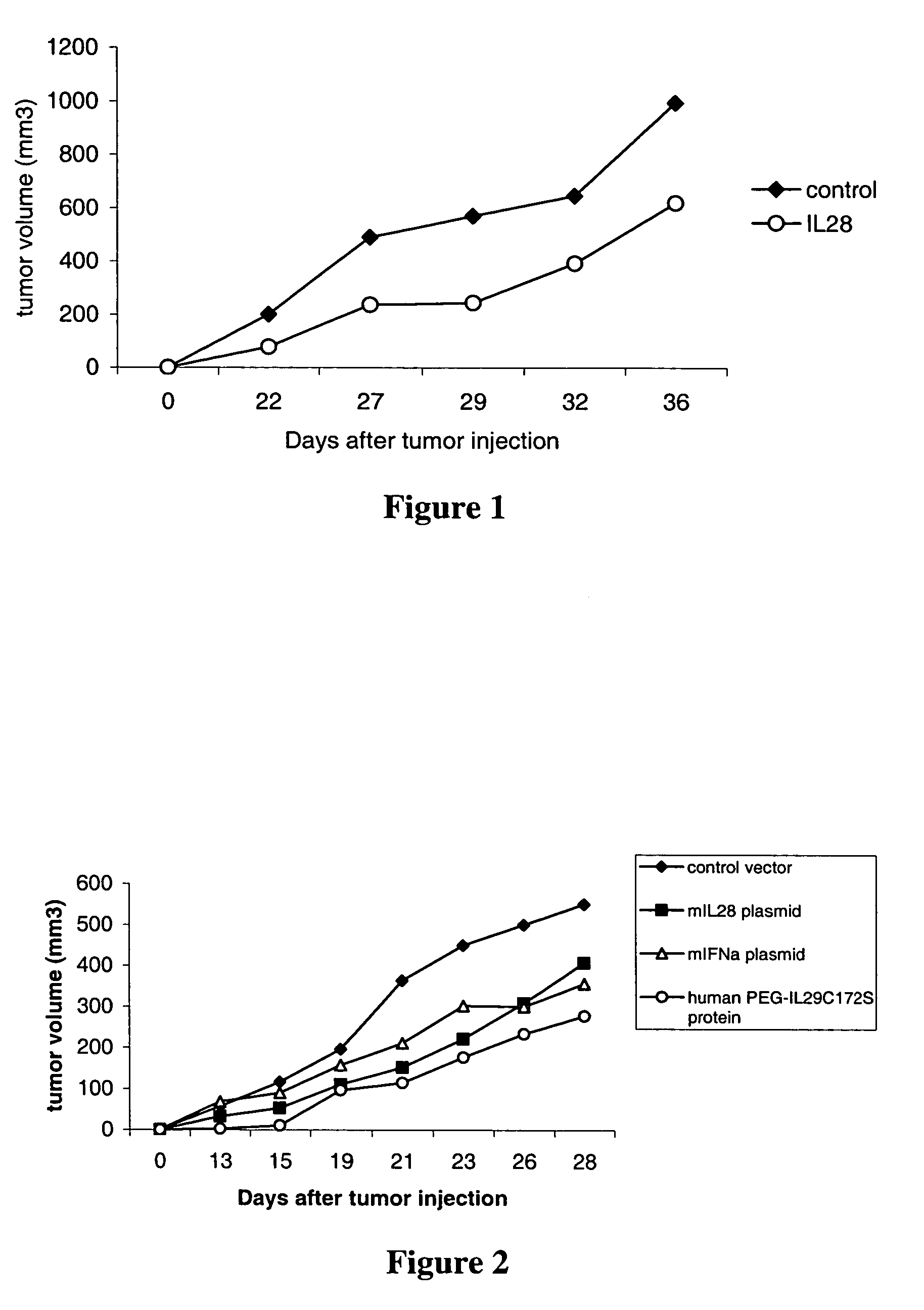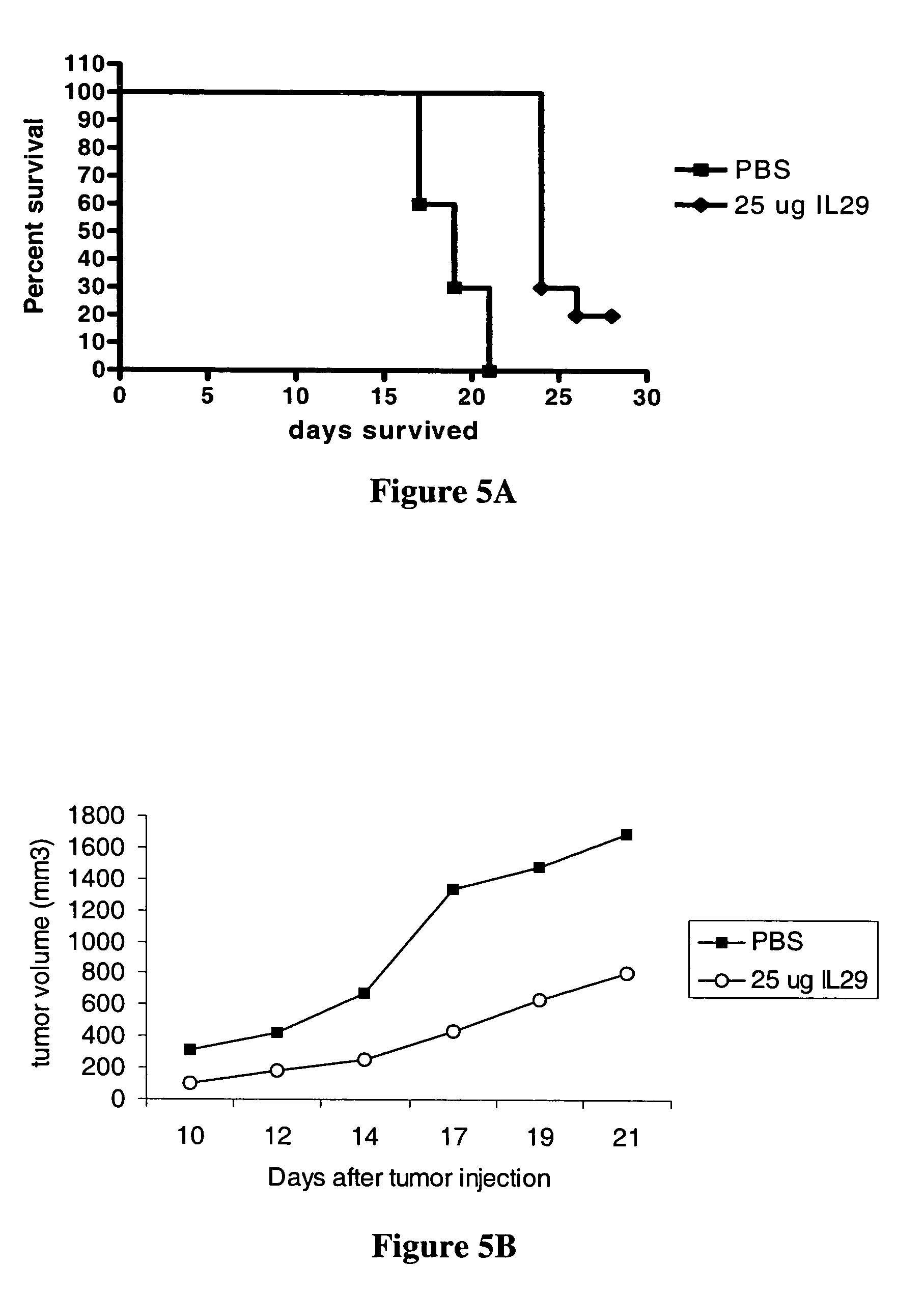Use of IL-28 and IL-29 to treat cancer and autoimmune disorders
a technology of il-28 and il-29, which is applied in the direction of immunological disorders, peptide/protein ingredients, extracellular fluid disorders, etc., can solve the problems of scarring damage to nerve fibers, loss of tolerance, and disruption of neurotransmission
- Summary
- Abstract
- Description
- Claims
- Application Information
AI Technical Summary
Benefits of technology
Problems solved by technology
Method used
Image
Examples
example 1
Mammalian Expression Plasmids
[0180]An expression plasmid containing zcyto20 and zcyto21 was constructed via homologous recombination. Fragments of zcyto20 and zcyto21 cDNA were generated using PCR amplification. The primers for PCR were as follows:
[0181]zcyto20 / pZMP21: zc40923, and zc43152 SEQ ID NOS: 42 and 43, respectively; and zcyto21 / pZMP21: zc40922, and zc43153 SEQ ID NOS:72 and 73, respectively.
[0182]The PCR reaction mixture was run on a 1% agarose gel and a band corresponding to the size of the insert was gel-extracted using a QIAquick™ Gel Extraction Kit (Qiagen, Valencia, Calif.).
[0183]The plasmid pZMP21, which was cut with BglII, was used for recombination with the PCR insert fragment. Plasmid pZMP21 is a mammalian expression vector containing an expression cassette having the MPSV promoter, and multiple restriction sites for insertion of coding sequences; an E. coli origin of replication; a mammalian selectable marker expression unit comprising an SV40 promoter, enhancer ...
example 2
Expression of Mammalian Constructs in CHO Cells
[0187]200 μg of a zcyto20 / pZMP21 and zcyto21 / pZMP21 construct were digested with 200 units of Pvu I at 37° C. for three hours and then were precipitated with IPA and spun down in a 1.5 mL microfuge tube. The supernatant was decanted off the pellet, and the pellet was washed with 1 mL of 70% ethanol and allowed to incubate for 5 minutes at room temperature. The tube was spun in a microfuge for 10 minutes at 14,000 RPM and the supernatant was aspirated off the pellet. The pellet was then resuspended in 750 μl of PF-CHO media in a sterile environment, and allowed to incubate at 60° C. for 30 minutes. CHO cells were spun down and resuspended using the DNA-media solution. The DNA / cell mixture was placed in a 0.4 cm gap cuvette and electroporated using the following parameters: 950 μF, high capacitance, and 300 V. The contents of the cuvette were then removed and diluted to 25 mLs with PF-CHO media and placed in a 125 mL shake flask. The flas...
example 3
Purification and Analysis of zcyto20-CHO Protein
A. Purification of Zcyto20-CHO Protein
[0188]Recombinant zcyto20 (IL-28A) protein was produced from a pool of DXB11-CHO cell lines. Cultures were harvested, and the media were sterile filtered using a 0.2 μm filter.
[0189]The purification of zcyto20-CHO protein was achieved by the sequential use of a Poros HS 50 column (Applied Biosystems, Framingham, Mass.), a Monolithic WCX column (Isco, Inc., Lincoln, Nebr.), a ToyoPearl Butyl 650S column (TosoH, Montgomeryville, Pa.), and a Superdex 75 column (Amersham Biosciences, Piscataway, N.J.). Culture media from DXB111-CHO were adjusted to pH 6.0 before loading onto a Poros 50 HS column. The column was washed with 50 mM MES (2-Morpholinoethanesulfonic acid), 100 mM NaCl, pH 6 and the bound protein was eluted with a 10 column volumes (CV) linear gradient to 60% of 50 mM MES, 2 M NaCl, pH 6. The eluting fractions were collected and the presence of zcyto20protein was confirmed by SDS-PAGE with a ...
PUM
 Login to View More
Login to View More Abstract
Description
Claims
Application Information
 Login to View More
Login to View More - R&D
- Intellectual Property
- Life Sciences
- Materials
- Tech Scout
- Unparalleled Data Quality
- Higher Quality Content
- 60% Fewer Hallucinations
Browse by: Latest US Patents, China's latest patents, Technical Efficacy Thesaurus, Application Domain, Technology Topic, Popular Technical Reports.
© 2025 PatSnap. All rights reserved.Legal|Privacy policy|Modern Slavery Act Transparency Statement|Sitemap|About US| Contact US: help@patsnap.com



